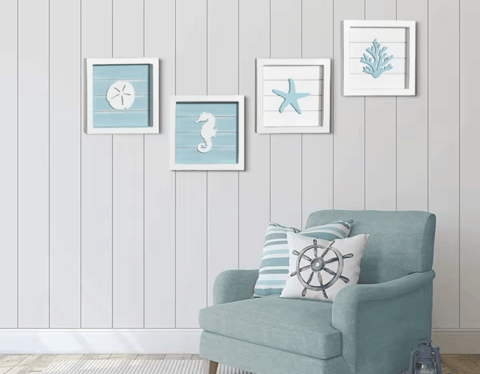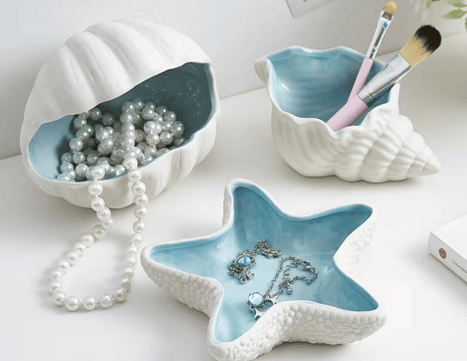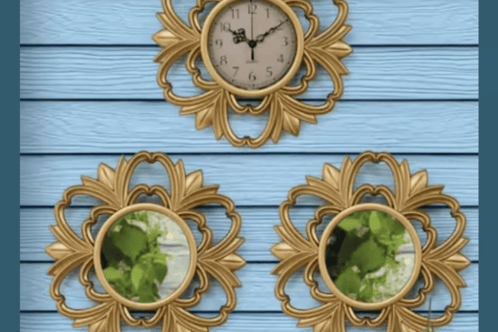The Timeless Elegance of Pale Blue: History, Design Applications, and Styling Tips
History, Design Applications, and Styling Tips
6/12/20257 min read


In the vast spectrum of colors that grace our living spaces, pale blue stands as a testament to timeless elegance and versatility. This gentle hue, reminiscent of clear skies and tranquil waters, has captivated interior designers and homeowners alike for centuries. Today, we'll explore the rich history of pale blue, its psychological effects, and practical applications in modern interior design – complete with styling tips to help you incorporate this serene shade into your own home.
The Fascinating History of Pale Blue
The story of blue in human history is one of rarity and prestige. Unlike earth tones that were readily available to our ancestors, blue pigments were extraordinarily difficult to source and create.
From Royal Beginnings to Modern Accessibility
The ancient Egyptians were among the first to harness blue, using the semi-precious stone lapis lazuli (mined exclusively in Afghanistan) to create a blue paste they associated with the heavens. This connection between blue and the divine persisted throughout many cultures and eras.
For centuries, blue remained elusive to most artists and decorators. When the stone was first imported to Europe, it was called "Ultramarine" (meaning "beyond the sea") and was considered more valuable than gold! This exclusivity cemented blue's association with royalty, wealth, and importance – a cultural connection that persists in our collective consciousness even today.
The democratization of blue began with the invention of Prussian blue in the early 18th century, when Johann Jacob Diesbach created a synthetic pigment that was much more affordable. This breakthrough allowed blue to spread beyond royal chambers and religious artwork into everyday homes.
Pale blue specifically gained popularity during the Victorian era, when lighter, airier interiors became fashionable. Paint analysis from this period shows blue was extensively used in Victorian interior decor, often in softer, more delicate shades that complemented the ornate furnishings of the time.
The Psychology of Pale Blue
There's a reason pale blue has endured as a favorite in interior design – it profoundly affects our psychological state. Research has shown that blue:
•Creates a sense of calm and tranquility
•Lowers blood pressure and heart rate
•Promotes feelings of peace and relaxation
•Enhances concentration and productivity
•Evokes cleanliness and clarity
Pale blue specifically strikes a perfect balance – it's soothing without being somber, refreshing without being overwhelming. This makes it an ideal backdrop for spaces where you want to create a serene atmosphere.
Incorporating Pale Blue in Modern Interiors
The beauty of pale blue lies in its remarkable versatility. It functions beautifully as both a neutral backdrop and a subtle accent color, adapting to various design styles from minimalist Scandinavian to eclectic bohemian. Here are eight thoughtful ways to bring this tranquil hue into your living spaces:
1. The Statement Sofa: A Centerpiece in Pale Blue
A pale blue sofa creates an instant focal point while maintaining a sense of calm sophistication. Unlike bolder colored sofas that can dominate a room, pale blue offers presence without overwhelming the space.
The Ball & Cast Calico 4-Piece Couch Living Room Set exemplifies this perfectly, offering a modular L-shaped design in a soothing pale blue-green that creates a serene living space with its clean lines and contemporary aesthetic.
Design Tip: Pair a pale blue sofa with warm wood tones to create balance, or with crisp whites for a fresh, coastal feel. Accent pillows in complementary colors like coral, mustard, or deeper blues can add depth and visual interest.
2. Color Drenching: Immersive Pale Blue Environments
For a bold yet calming statement, consider "color drenching" – painting walls, ceiling, woodwork, and even radiators in the same pale blue shade. This technique creates a cohesive, enveloping atmosphere that feels both contemporary and timeless.
Design Tip: When color drenching, use different paint finishes to create subtle texture variations. For example, eggshell on walls, satin on woodwork, and a specialized radiator paint for heating elements. This adds dimension while maintaining color consistency.
3. Architectural Interest: Pale Blue Wall Paneling
Wall paneling in pale blue adds architectural interest and texture to any room. Whether you opt for traditional wainscoting, modern fluted panels, or simple board and batten, pale blue elevates these features with a touch of refined color.
Design Tip: Consider painting only the paneled portion of your walls in pale blue, leaving the upper sections white for a fresh, balanced look. Alternatively, go bold with full-height pale blue paneling for a more dramatic effect.
4. Soft Furnishings: Low-Commitment Pale Blue Accents
For those hesitant to commit to larger pale blue elements, soft furnishings offer a perfect entry point. Cushions, throws, curtains, and bedding in pale blue can transform a space without permanent changes – ideal for renters or those who like to update their decor seasonally.
The Marcielo 3-Piece 100% Cotton Oversized Bedspread Set provides a beautiful foundation for layering pale blue accents in a bedroom setting.
Design Tip: Mix different textures in the same pale blue family – think velvet cushions, knitted throws, and linen curtains – to create visual depth while maintaining a cohesive color scheme.
5. Grounding Elements: Pale Blue Area Rugs
A pale blue rug can anchor a room while adding a sense of calm to the foundation of your space. In open-plan homes, rugs are particularly effective at defining distinct areas while maintaining visual flow.
Design Tip: In high-traffic areas, look for pale blue rugs with subtle patterns that help disguise inevitable wear and stains. Geometric designs or traditional patterns in pale blue can add interest while remaining practical.
6. Tableware and Accessories: Functional Pale Blue Touches
Incorporating pale blue through everyday objects adds touches of serenity to daily rituals. Consider the Japanese Style Master Cup Ice Cracked Glaze Tea Set with its beautiful pale blue marbled glaze pattern, or the Ceramic Tableware Noodle Soup Dessert Bowl featuring a soothing pale blue-green hue with speckled texture and natural rope handles.
Design Tip: Display pale blue ceramics, vases, or decorative objects on open shelving or in glass-fronted cabinets where they can be appreciated as both functional items and design elements.
7. Outdoor Living: Extending Pale Blue Beyond Interior Spaces
Pale blue works beautifully in outdoor settings, creating a natural transition between sky, water, and your living space. The Picnic Table Cover with Bench Covers in a lovely pale blue floral pattern brings this serene hue to outdoor dining experiences.
For ultimate outdoor relaxation, the Brazilian Double Hammock in blue-green creates a perfect retreat for warm weather lounging.
Design Tip: Echo your interior pale blue scheme in outdoor spaces for visual continuity between indoor and outdoor living areas. Weather-resistant fabrics and materials now come in beautiful pale blue options that can withstand the elements.
8. Artistic Expressions: Pale Blue in Artwork and Wall Decor
Artwork featuring pale blue can serve as a focal point or complement an existing color scheme. Whether it's abstract paintings, photography of sky and sea, or textile art, pale blue artwork adds depth and interest to walls.
Design Tip: Create a gallery wall mixing different mediums that incorporate pale blue – perhaps combining framed prints, textile pieces, and three-dimensional objects for a curated, collected look.
Perfect Pairings: Colors That Complement Pale Blue
Pale blue's versatility extends to its compatibility with numerous other colors. Here are some particularly effective combinations:
•Crisp White: For a fresh, coastal aesthetic
•Warm Woods: To balance cool tones with natural warmth
•Soft Greys: For a sophisticated, contemporary look
•Coral or Terracotta: To create energizing contrast
•Navy Blue: For depth and dimension within the same color family
•Sage Green: For a nature-inspired, harmonious palette
•Pale Pink: For a soft, contemporary combination
Practical Applications for Different Rooms
Living Room
Pale blue creates a welcoming, relaxing atmosphere in living spaces. Consider a pale blue sofa as your anchor piece, complemented by neutral walls and warm wood accents. Alternatively, pale blue walls provide a serene backdrop for artwork and furnishings.
Bedroom
The calming properties of pale blue make it ideal for bedrooms. From wall color to bedding, this hue promotes restful sleep and peaceful mornings. Layer different textures in varying shades of pale blue for a sophisticated, tranquil retreat.
Kitchen
Pale blue cabinetry offers a fresh alternative to white or wood, while pale blue backsplash tiles add subtle color that complements many countertop materials. Even small additions like pale blue dishware displayed on open shelving can transform a kitchen's atmosphere.
Bathroom
Pale blue naturally evokes water and cleanliness, making it perfect for bathrooms. Consider pale blue tiles, painted vanities, or accessories to create a spa-like atmosphere.
Home Office
The concentration-enhancing properties of blue make pale blue an excellent choice for home offices. A pale blue accent wall behind your desk can help maintain focus without being distracting.
Conclusion: The Enduring Appeal of Pale Blue
From its royal beginnings to its current status as a designer favorite, pale blue has proven its staying power in interior design. Its ability to calm, refresh, and adapt to various styles ensures it will remain a beloved choice for years to come.
Whether you embrace pale blue through a statement furniture piece, a color-drenched room, or simply a few carefully chosen accessories, this versatile hue offers endless possibilities for creating spaces that feel both timeless and thoroughly contemporary.
By understanding its history, psychological effects, and practical applications, you can confidently incorporate pale blue into your home in ways that enhance both its aesthetic appeal and its livability.
Affiliate Disclaimer: This blog post contains affiliate links. When you purchase products through these links, we may earn a small commission at no additional cost to you. These commissions help support this blog and allow us to continue providing free content. We only recommend products we genuinely believe in and would use too. Thank you for your support!






Links
Follow us on social media
alleatorika@proton.me
Contact information:
© 2025. All rights reserved.